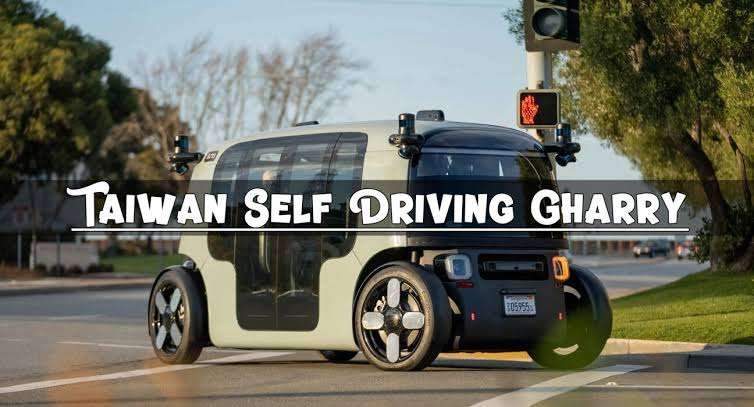Welcome to the future of commerce! Today, we delve into the cutting-edge world of self-driving gharry and how they are revolutionizing Taipei’s bustling streets. The intertwining tales of technology and convenience have reached an all-time high as these autonomous vehicles navigate through intricate cityscapes, offering a glimpse into a world where efficiency seamlessly dances with innovation. Buckle up as we unravel the remarkable journey of Taipei’s self-driving gharry – the driving force behind tomorrow’s commerce landscape.
Introduction to the Self-Driving Gharry in Taipei
The concept of self-driving vehicles is not a new one, but it has gained traction in recent years with the rapid advancements in technology. These autonomous vehicles are proving to be revolutionary in various industries, including transportation and commerce. One such groundbreaking innovation is the self-driving gharry in Taipei.
A gharry, also known as a rickshaw or pedicab, is a popular mode of transport in many Asian countries. However, the traditional gharry relies on human power for its movement, which can be physically demanding for drivers and limits their working hours. In 2017, the Taiwanese company 9Solutions unveiled their prototype for a self-driving gharry that uses electric motors and advanced sensors to navigate through traffic without any human input.
This transformational invention has sparked interest from both locals and tourists alike. The introduction of self-driving vehicles has brought about significant changes not only to the transportation industry but also to commerce in general.
One of the major advantages of self-driving gharies is their ability to operate continuously without rest breaks or shifts like traditional human-driven vehicles. This increased efficiency means faster delivery times for goods and services and quicker commutes for passengers. With fewer limitations on operating hours, businesses can extend their reach beyond regular business hours and cater to more customers.
Moreover, this innovative technology offers a greener alternative to traditional modes of transport as it runs solely on electricity. The reduction in carbon emissions plays an essential role in promoting sustainability within cities like Taipei, where air pollution is a significant concern.
Another significant benefit of these autonomous gharies is their enhanced safety features due to their use of advanced sensors and cutting-edge software systems. These vehicles can detect obstacles on the road and make real-time adjustments accordingly to avoid accidents. Additionally, with precise navigation capabilities, they reduce instances of getting lost or taking longer routes.
The introduction of self-driving vehicles has also opened up new opportunities for businesses to incorporate these vehicles into their logistics operations. For example, they can be used to deliver goods from warehouses to stores or even in-house delivery services within a business complex.
The self-driving gharry in Taipei is pushing the boundaries of technological advancements and changing the landscape of transportation and commerce. With its many benefits, it is undoubtedly revolutionizing how we perceive and interact with these traditional modes of transport. As this technology continues to advance, we can expect to see more innovative solutions that will bring about positive changes in various industries across the world.
The Evolution of Transportation Technology
The world of transportation has undergone a massive transformation over the years, with advancements in technology playing a crucial role. From the invention of the wheel to the development of electric and self-driving vehicles, each era has seen remarkable changes in how we navigate from one place to another.
The earliest mode of transportation was walking, which allowed humans to travel short distances and explore new territories. As societies grew and civilizations flourished, people began to use animals such as horses and camels for transportation. This marked the beginning of animal-powered transportation, which improved speed and efficiency for trade and commerce.
In 1885, Karl Benz invented the first gasoline-powered automobile, sparking a revolution in personal transportation. The internal combustion engine quickly replaced animal-powered modes of transit, leading to significant advances in automotive technology. With the introduction of Henry Ford’s assembly line production system, cars became more affordable and accessible to the general public.
As air travel gained popularity in the early 20th century, it brought about an entirely new dimension in transportation technology. The Wright brothers’ successful flight opened up opportunities for commercial airlines, offering faster and more convenient ways to reach distant destinations. In addition, aircraft innovation led to developments like jet engines and supersonic planes that reduced travel time drastically.
The late 20th century saw an increased focus on sustainable transportation alternatives due to concerns about environmental degradation caused by fossil fuels. Electric cars emerged as a promising solution with their zero-emission capabilities but faced challenges due to limited battery life and lack of infrastructure support.
In recent years, there has been a tremendous push towards technological advancements that are shaping our future mobility solutions. One such innovation is self-driving vehicles spearheaded by companies like Google Waymo and Tesla Motors. These autonomous vehicles use sensors and high-definition maps combined with advanced algorithms to navigate roads without human input.
Taipei’s self-driving gharry is one such example that utilizes state-of-the-art technologies such as lidar sensors, cameras, and 5G connectivity to transport goods around the city autonomously. This game-changing technology has revolutionized the world of commerce by streamlining logistics processes, reducing transportation costs, and increasing efficiency.
The evolution of transportation technology has undoubtedly made our lives more convenient and efficient. With ongoing advancements like flying cars, hyperloop systems, and smart roads being explored, the future of transportation looks incredibly promising. As we continue to embrace these technological advancements, it’s essential to ensure their sustainability and responsible use for a better world.
How the Self-Driving Gharry Works and its Features
The self-driving gharry in Taipei has been making headlines as one of the most innovative and advanced modes of transportation. But how does it actually work? In this section, we will delve into the technology behind the self-driving gharry and explore its key features.
At the heart of the self-driving gharry is a complex system of sensors, cameras, radars, and GPS technology. These components work together to create a detailed map of the vehicle’s surroundings and communicate with each other to ensure safe navigation on the road.
One of the main features that sets this self-driving gharry apart from traditional vehicles is its use of LiDAR (Light Detection And Ranging) technology. This involves emitting beams of light that bounce off objects in its path, creating a 3D map of its environment. This allows the vehicle to detect any obstacles or pedestrians around it in real-time.
In addition to LiDAR, the self-driving gharry also uses radar sensors to measure distances between objects and gauge their speed. Cameras are also an essential component, providing visual information for navigation and object detection.
Another crucial feature is the use of GPS technology, which enables precise positioning on roads and accurate route mapping. The vehicle’s central computer receives all this data from various sensors and processes it using advanced algorithms. It then makes decisions on acceleration, braking, steering, and navigation based on this information.
But what happens if there is a sudden change in traffic or an unexpected obstacle appears? That’s where artificial intelligence (AI) comes into play. The self-driving gharry utilizes machine learning algorithms that constantly analyze real-time data from previous trips to make quick decisions in unusual situations.
Aside from ensuring safety on the roads, another significant feature is energy efficiency. With electric motors powering these vehicles instead of traditional gasoline engines, they produce zero emissions while operating autonomously – reducing carbon footprints significantly.
Furthermore, these vehicles come equipped with collision avoidance systems, emergency braking technology, and automatic lane-keeping capabilities. The self-driving gharry also has the ability to communicate with other vehicles through vehicle-to-vehicle (V2V) communication, making it an even safer mode of transportation.
The self-driving gharry in Taipei is a technological marvel, combining various advanced components to bring efficient and safe transportation solutions. As this technology continues to evolve and improve, we can expect to see more self-driving gharries on the roads not just in Taipei but worldwide. Embracing these advancements will undoubtedly revolutionize the world of commerce and transportation for years to come.
Advantages of the Self-Driving Gharry for Businesses
The Self-Driving Gharry in Taipei has taken the world by storm, with its innovative and futuristic approach to transportation. While this revolutionary mode of travel offers convenience and ease to passengers, it also holds tremendous advantages for businesses. In this section, we will explore the various benefits that the Self-Driving Gharry brings to enterprises and how it is transforming the world of commerce.
- 1. Increased Efficiency:
One of the biggest advantages of the Self-Driving Gharry for businesses is increased efficiency. With traditional modes of transportation, companies have to rely on human drivers who may get tired or make mistakes. However, with self-driving technology taking over, these concerns are eliminated as the vehicle is guided by advanced sensors, GPS systems and intelligent algorithms. This results in a more accurate and faster means of transportation, which can significantly improve logistics and supply chain management.
- 2. Cost-effective:
In today’s competitive business landscape, controlling costs is crucial for survival and growth. One way companies can reduce expenses is by utilizing self-driving vehicles like the Gharry for their operations. Unlike a traditional taxi or ride-sharing service where there is a charge per trip basis or hourly wage for drivers; self-driving cars offer fixed operating costs which do not change regardless of time or distance traveled. This cost-effectiveness makes it an attractive option for businesses looking to optimize their budget without compromising on quality.
- 3. Enhanced Safety:
With autonomous vehicles being equipped with advanced collision avoidance systems and robust safety features; traveling through busy streets has never been safer! These enhanced safety capabilities extend beyond protecting just riders but also cargo that may be transported from one location to another with minimal risk involved due to human error.
- 4. Flexibility:
The flexibility provided by Self-Driving Gharrys opens up new possibilities in areas such as courier services and product deliveries – especially when same-day delivery expectations continue increasing exponentially worldwide as customer needs adjust accordingly into having multiple orders delivered quickly within hours apart. These vehicles can operate 24/7 and can be programmed to take multiple stops in one ride, further optimizing time and resources for businesses.
- 5. Data-driven Insights:
The self-driving technology of the Gharry offers access to real-time data about demographics, traffic patterns, and peak travel times. With this information at hand, businesses can make intelligent decisions on routes, pricing strategies, and even product offerings based on the needs of their target audience. Additionally, analyzing this data can also help them identify opportunities for growth and expansion into new markets.
The Self-Driving Gharry is a game-changer for businesses seeking operational efficiency, cost-effectiveness, enhanced safety measures, flexibility, and valuable insights from data analytics – all while providing an exceptional customer experience. As this technology continues to evolve and become more widespread globally, it’s safe to say that we are witnessing the beginning of a new era in transportation that will undoubtedly revolutionize the world of commerce as we know it.
Impact on Taipei’s Commerce Industry
The bustling city of Taipei has always been known as a commercial hub, with its vibrant night markets, shopping districts, and strong business atmosphere. However, the arrival of self-driving technologies has taken the city’s commerce industry to new heights. This revolutionary technology has had a tremendous impact on Taipei’s economy and businesses.
One of the most significant impacts of self-driving technologies on Taipei’s commerce industry is convenience. These autonomous vehicles have made it easier for both consumers and businesses to transport goods from one place to another. With traditional delivery services, there are often delays or scheduling conflicts that can disrupt business operations. However, self-driving gharrys offer 24/7 service and can navigate through traffic more efficiently, reducing delivery times significantly. This increased efficiency has also resulted in cost savings for businesses, making their operations more cost-effective.
Moreover, the use of self-driving gharrys has also enabled smaller businesses to compete with larger corporations in terms of logistics. In the past, small businesses often struggled with managing their transportation needs due to high costs or limited resources. With self-driving gharrys, they now have access to affordable and reliable delivery services which allow them to expand their reach and compete in a global market.
Another notable impact is on customer experience. Self-driving gharrys provide a seamless delivery experience for customers by eliminating human errors in traditional transportation methods such as incorrect addresses or lost packages. The tracking capabilities of these vehicles also give customers real-time updates on their deliveries, increasing transparency and trust between businesses and consumers.
Furthermore, self-driving gharrys have also opened up new opportunities for last-mile delivery services in Taipei’s commerce industry. With traditional transportation methods such as trucks or scooters being unable to reach narrow streets or pedestrian-only areas efficiently, self-driving gharrys have proven to be a game-changer in making timely deliveries within urban cities like Taipei.
The introduction of this advanced technology has also led to a shift towards a more sustainable and eco-friendly commerce industry in Taipei. Self-driving gharrys run on electricity, reducing carbon emissions and contributing to the city’s efforts towards creating a more environmentally friendly transport system.
It is evident that self-driving gharrys have had a profound impact on Taipei’s commerce industry by revolutionizing traditional delivery methods. The convenience, cost-effectiveness, improved customer experience, and sustainable practices have made this technology an integral part of Taipei’s booming economy and will continue to shape its commerce industry for years to come.
Comparing the Self-Driving Gharry to Traditional Modes of Transportation
The introduction of self-driving technology has sparked a revolutionary wave in the transportation industry, with countless innovations popping up all over the globe. One such advancement that has captivated the attention of many is Taipei’s self-driving gharry. This autonomous vehicle promises to revolutionize the world of commerce by offering efficient and convenient transportation services to businesses.
In this section, we will delve deeper into understanding how this cutting-edge technology compares to traditional modes of transportation. We will explore various factors such as safety, cost, and convenience to give a comprehensive overview of this innovative mode of transport.
To begin with, safety is a crucial factor when it comes to transportation. The traditional gharrys rely on manual operation by human drivers which may lead to human errors resulting in accidents. On the other hand, self-driving gharrys use advanced sensors and software to navigate their way around traffic making them less susceptible to accidents caused by human error. Additionally, these vehicles are equipped with features such as lane departure warnings and emergency braking systems which enhances their safety measures even further.
Another significant aspect that sets self-driving gharrys apart from traditional modes of transportation is cost-effectiveness. With conventional gharrys, businesses have to bear the cost of hiring drivers and fuel expenses. In contrast, self-driving gharrys eliminate these costs entirely as they do not require any human labor or fuel consumption. This makes them more financially viable for businesses looking for more budget-friendly options without compromising on efficiency.
Moreover, convenience plays an integral role in deciding the mode of transport for most companies. Traditional gharrys operate on fixed routes and schedules leading to delays and inconvenience at times. However, self-driving gharrys offer greater flexibility as they can be programmed according to specific business needs allowing for faster delivery times and customized routes based on real-time traffic data.
Furthermore, these autonomous vehicles also contribute towards reducing carbon emissions through their eco-friendly design powered by electricity rather than fossil fuels. This makes them a more sustainable alternative for businesses looking to reduce their carbon footprint.
The self-driving gharry is undoubtedly transforming the world of commerce with its advanced features and cost-effective solutions. Its safety, financial viability, convenience, and eco-friendly design make it a desirable option for businesses. With these significant advantages in mind, it’s not surprising that this innovative mode of transportation is gaining popularity at a rapid pace globally.
Skepticism and Concerns Surrounding Autonomous Vehicles
The Future of Self-Driving Technology and Its Potential Global Reach
Conclusion:
In conclusion, the future of self-driving technology is undeniably exciting, offering the potential to reshape the landscape of transportation and society at large. By embracing innovation responsibly and collaboratively, we can unlock the full benefits of self-driving technology, creating a safer, more efficient, and interconnected world for generations to come.



5 Comments
Pingback: "Ubisoft Singapore: Breaking Gaming News" best 1
Pingback: "Verizon Dividend Trends: Insights for Investors" best 1
Pingback: "Eid 2024: Marking the End of Ramadan" best 1
Pingback: Best VPS Providers for Reliable and Scalable Hosting 1
Pingback: Self-Driving Taipei in Style: Self-Driving Gharry best 1